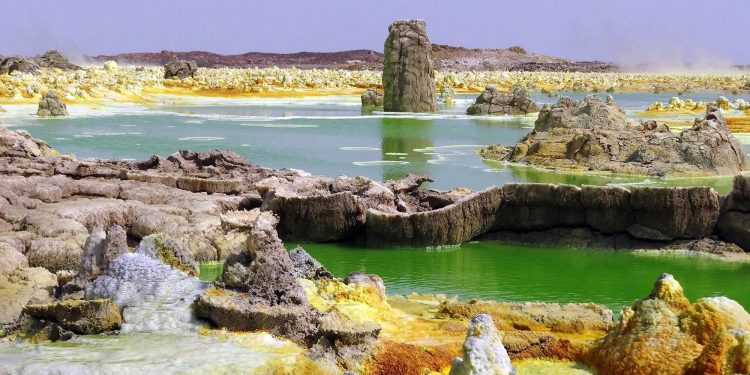Addis Ababa: There is one confirmed place on Earth which does not harbour any form of life despite presence of water: Hot, saline, hyperacid ponds in the Dallol geothermal field in Ethiopia.
It means that the presence of liquid water on a planet, which is often used as a habitability criterion, does not directly imply that it has life. Living beings, especially microorganisms, have a surprising ability to adapt to the most extreme environments on our planet but not at the Dallol geothermal field.
The infernal landscape of Dallol, located in the Ethiopian depression of Danakil, extends over a volcanic crater full of salt, where toxic gases emanate and water boils in the midst of intense hydrothermal activity.
It is one of the most torrid environments on Earth. There, daily temperatures in winter can exceed 45 degrees Celsius and there are abundant hypersaline and hyperacid pools, with pH values that are even negative.
“After analysing many more samples than in previous works, with adequate controls so as not to contaminate them and a well-calibrated methodology, we have verified that there’s no microbial life in these salty, hot and hyperacid pools or in the adjacent magnesium-rich brine lakes,” said biologist Purificacion Lopez Garcia of the French National Centre for Scientific Research who led a French-Spanish team of scientists.
The team has published an article in the journal Nature Ecology and Evolution that concludes there is no life in Dallol’s multi-extreme ponds.
“What does exist is a great diversity of halophilic archaea (a type of primitive salt-loving microorganisms) in the desert and the saline canyons around the hydrothermal site, but neither in the hyperacid and hypersaline pools themselves, nor in the so-called Black and Yellow lakes of Dallol, where magnesium abounds,” explained Garcia.
All this despite the fact that microbial dispersion in this area, due to the wind and to human visitors, is intense, the biologist added.
This is confirmed by the results of all the various methods used by the team, including the massive sequencing of genetic markers to detect and classify microorganisms, microbial culture attempts, fluorescent flow cytometry to identify individual cells, chemical analysis of brines and scanning electron microscopy combined with X-ray spectroscopy.
According to the authors, this work “helps to circumscribe the limits of habitability and demands caution when interpreting morphological bio-signatures on Earth and beyond,” that is, one should not rely on the apparently cellular or ‘biological’ aspect of a structure, because it could have an abiotic origin.
“In addition, our study presents evidence that there are places on the Earth’s surface, such as the Dallol pools, which are sterile even though they contain liquid water,” stressed Garcia.
In this case, the researchers have found two physical-chemical barriers that prevent the presence of living organisms in ponds: the abundance of chaotropic magnesium salts (an agent that breaks hydrogen bridges and denatures biomolecules) and the simultaneous confluence of hypersaline, hyperacid and high-temperature conditions.
“We would not expect to find life forms in similar environments on other planets, at least not based on a biochemistry similar to terrestrial biochemistry,” Garcia noted.
The researcher cautioned on the need to have multiple indications, to analyse all types of alternatives and to be very prudent with interpretations before reaching any conclusions in astrobiology.






































